
FTI Consulting, Inc. Current Investor Presentation October 2018 Exhibit 99.1
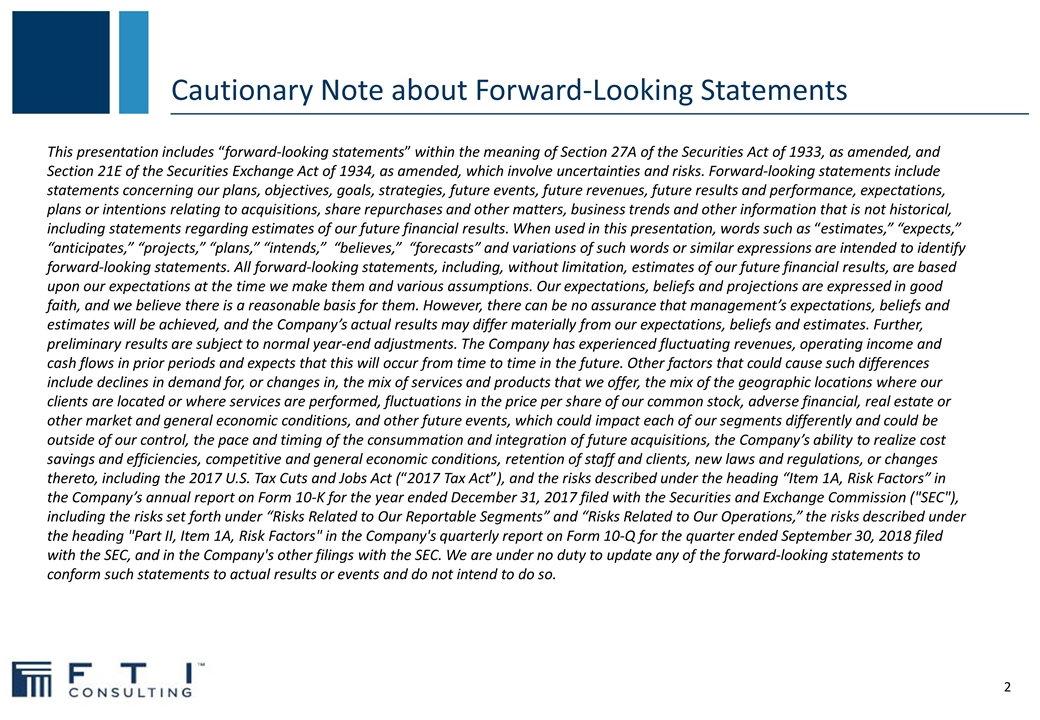
Cautionary Note about Forward-Looking Statements This presentation includes “forward-looking statements” within the meaning of Section 27A of the Securities Act of 1933, as amended, and Section 21E of the Securities Exchange Act of 1934, as amended, which involve uncertainties and risks. Forward-looking statements include statements concerning our plans, objectives, goals, strategies, future events, future revenues, future results and performance, expectations, plans or intentions relating to acquisitions, share repurchases and other matters, business trends and other information that is not historical, including statements regarding estimates of our future financial results. When used in this presentation, words such as “estimates,” “expects,” “anticipates,” “projects,” “plans,” “intends,” “believes,” “forecasts” and variations of such words or similar expressions are intended to identify forward-looking statements. All forward-looking statements, including, without limitation, estimates of our future financial results, are based upon our expectations at the time we make them and various assumptions. Our expectations, beliefs and projections are expressed in good faith, and we believe there is a reasonable basis for them. However, there can be no assurance that management’s expectations, beliefs and estimates will be achieved, and the Company’s actual results may differ materially from our expectations, beliefs and estimates. Further, preliminary results are subject to normal year-end adjustments. The Company has experienced fluctuating revenues, operating income and cash flows in prior periods and expects that this will occur from time to time in the future. Other factors that could cause such differences include declines in demand for, or changes in, the mix of services and products that we offer, the mix of the geographic locations where our clients are located or where services are performed, fluctuations in the price per share of our common stock, adverse financial, real estate or other market and general economic conditions, and other future events, which could impact each of our segments differently and could be outside of our control, the pace and timing of the consummation and integration of future acquisitions, the Company’s ability to realize cost savings and efficiencies, competitive and general economic conditions, retention of staff and clients, new laws and regulations, or changes thereto, including the 2017 U.S. Tax Cuts and Jobs Act (“2017 Tax Act”), and the risks described under the heading “Item 1A, Risk Factors” in the Company’s annual report on Form 10-K for the year ended December 31, 2017 filed with the Securities and Exchange Commission ("SEC"), including the risks set forth under “Risks Related to Our Reportable Segments” and “Risks Related to Our Operations,” the risks described under the heading "Part II, Item 1A, Risk Factors" in the Company's quarterly report on Form 10-Q for the quarter ended September 30, 2018 filed with the SEC, and in the Company's other filings with the SEC. We are under no duty to update any of the forward-looking statements to conform such statements to actual results or events and do not intend to do so.
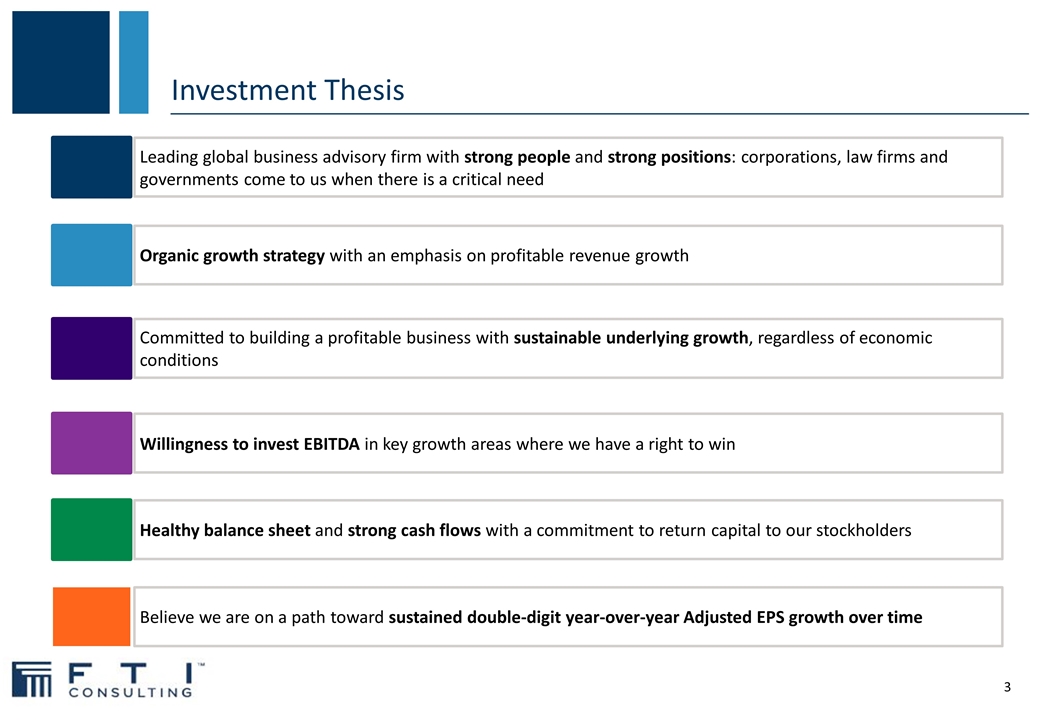
Investment Thesis Leading global business advisory firm with strong people and strong positions: corporations, law firms and governments come to us when there is a critical need Committed to building a profitable business with sustainable underlying growth, regardless of economic conditions Willingness to invest EBITDA in key growth areas where we have a right to win Healthy balance sheet and strong cash flows with a commitment to return capital to our stockholders Organic growth strategy with an emphasis on profitable revenue growth Believe we are on a path toward sustained double-digit year-over-year Adjusted EPS growth over time

FCN Publicly Traded $2.8BLN 1982 Year Founded 4,600+ Total Employees Worldwide 490+ Senior Managing Directors 9 9 Specialized Industry Practice Groups 2 Nobel Laureates 8/10 Advisor to 8 of the World’s Top 10 Bank Holding Companies 96/100 Advisor to 96 of the World’s Top 100 Law Firms 53/100 53 of Global 100 Corporations are Clients FTI Consulting: Experts with Impact 76 Offices in 76 Cities Around the Globe Equity Market Capitalization1 All statistics above are as of September 30, 2018. 1Number of total shares outstanding as of October 18, 2018, times the closing share price as of October 25, 2018.
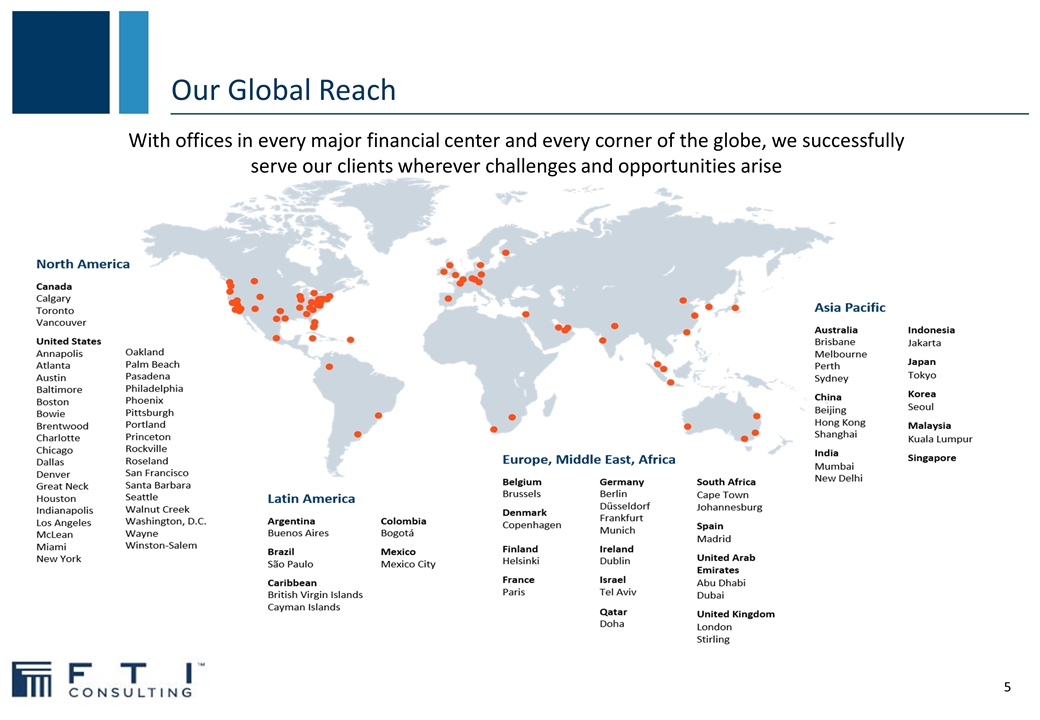
Our Global Reach With offices in every major financial center and every corner of the globe, we successfully serve our clients wherever challenges and opportunities arise

Business Snapshot: Five Segments, One Purpose Corporate Finance & Restructuring Economic Consulting Forensic and Litigation Consulting Strategic Communications Technology FTI Consulting is organized into five segments, each of which is a global leader in its own right for one simple reason: our commitment to having a tangible, positive impact on how our clients confront and manage change and risk

Segment Snapshot: Revenues and Total Adjusted Segment EBITDA Q3 2018 Segment Revenues Q3 2018 Total Adjusted Segment EBITDA¹ Corporate Finance & Restructuring Forensic and Litigation Consulting Economic Consulting Technology Strategic Communications ¹See accompanying financial tables and “End Notes: FTI Consulting Non-GAAP Financial Measures” for the definition and reconciliations of Total Adjusted Segment EBITDA, which is a non-GAAP financial measure. .
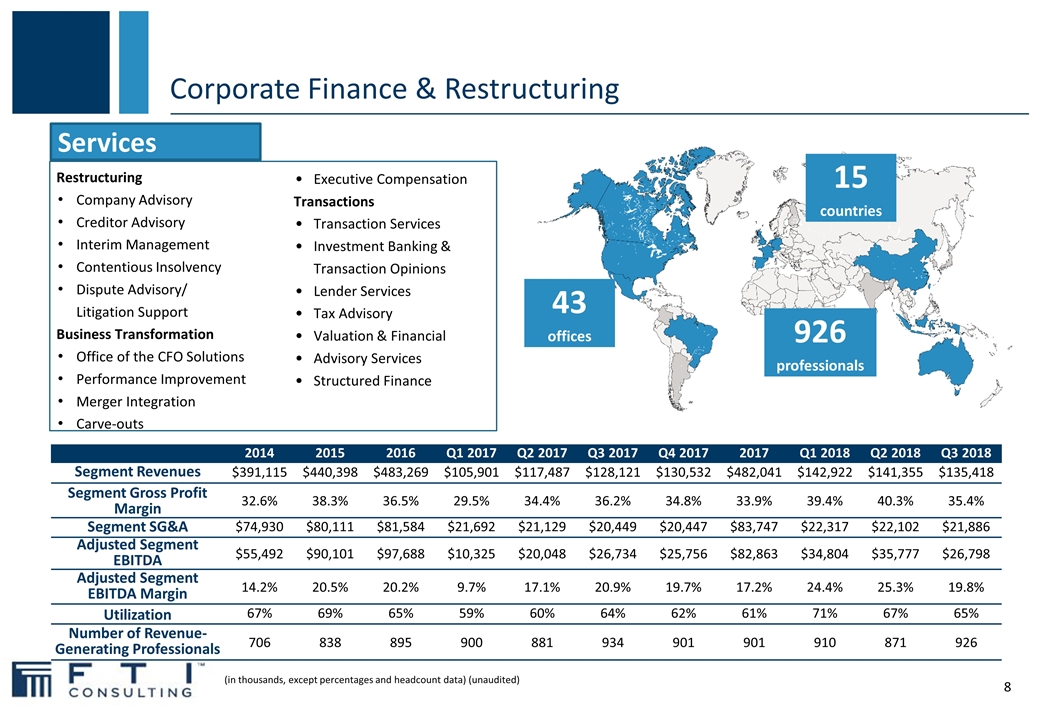
43 offices 926 professionals 15 countries Corporate Finance & Restructuring 2014 2015 2016 Q1 2017 Q2 2017 Q3 2017 Q4 2017 2017 Q1 2018 Q2 2018 Q3 2018 Segment Revenues $391,115 $440,398 $483,269 $105,901 $117,487 $128,121 $130,532 $482,041 $142,922 $141,355 $135,418 Segment Gross Profit Margin 32.6% 38.3% 36.5% 29.5% 34.4% 36.2% 34.8% 33.9% 39.4% 40.3% 35.4% Segment SG&A $74,930 $80,111 $81,584 $21,692 $21,129 $20,449 $20,447 $83,747 $22,317 $22,102 $21,886 Adjusted Segment EBITDA $55,492 $90,101 $97,688 $10,325 $20,048 $26,734 $25,756 $82,863 $34,804 $35,777 $26,798 Adjusted Segment EBITDA Margin 14.2% 20.5% 20.2% 9.7% 17.1% 20.9% 19.7% 17.2% 24.4% 25.3% 19.8% Utilization 67% 69% 65% 59% 60% 64% 62% 61% 71% 67% 65% Number of Revenue-Generating Professionals 706 838 895 900 881 934 901 901 910 871 926 (in thousands, except percentages and headcount data) (unaudited) Restructuring Company Advisory Creditor Advisory Interim Management Contentious Insolvency Dispute Advisory/ Litigation Support Business Transformation Office of the CFO Solutions Performance Improvement Merger Integration Carve-outs Services Executive Compensation Transactions Transaction Services Investment Banking & Transaction Opinions Lender Services Tax Advisory Valuation & Financial Advisory Services Structured Finance

Corporate Finance & Restructuring (continued) The Corporate Finance & Restructuring segment focuses on strategic, operational, financial and capital needs of businesses by addressing the full spectrum of financial and transactional challenges faced by companies, boards, private equity sponsors, creditor constituencies and other stakeholders. Medium-Term Growth Opportunities Enhance Business Transformation and Transaction capabilities Grow Restructuring globally Deeper penetration of key industries e.g., Retail, Healthcare, TMT, Industrials, Automotive and Energy Segment Offering Revenues increased $7.3 million, or 5.7%, from Q3 2017 to Q3 2018. The revenue increase was driven by increased demand in our business transformation and transaction services in North America and EMEA, partially offset by lower success fees. Gross profit increased $1.5 million, or 3.3%, from Q3 2017 to Q3 2018. Gross profit margin decreased 0.8 percentage points from Q3 2017 to Q3 2018. This decrease in gross profit margin was primarily due to an increase in salary expense related to strategic hires as well as an increase in variable compensation. Adjusted Segment EBITDA was $26.8 million, or 19.8% of segment revenues, compared to $26.7 million, or 20.9% of segment revenues, in the prior year. Q3 2018 Key Financial Commentary
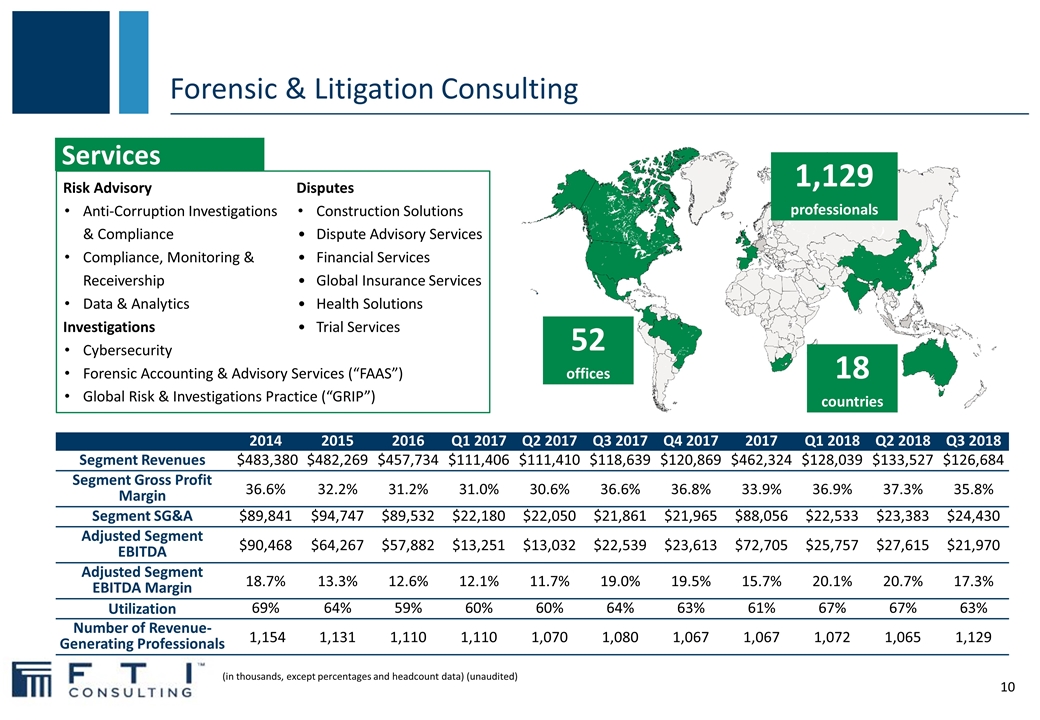
Forensic & Litigation Consulting 52 offices 1,129 professionals 18 countries Risk Advisory Anti-Corruption Investigations & Compliance Compliance, Monitoring & Receivership Data & Analytics Investigations Cybersecurity Forensic Accounting & Advisory Services (“FAAS”) Global Risk & Investigations Practice (“GRIP”) Services 2014 2015 2016 Q1 2017 Q2 2017 Q3 2017 Q4 2017 2017 Q1 2018 Q2 2018 Q3 2018 Segment Revenues $483,380 $482,269 $457,734 $111,406 $111,410 $118,639 $120,869 $462,324 $128,039 $133,527 $126,684 Segment Gross Profit Margin 36.6% 32.2% 31.2% 31.0% 30.6% 36.6% 36.8% 33.9% 36.9% 37.3% 35.8% Segment SG&A $89,841 $94,747 $89,532 $22,180 $22,050 $21,861 $21,965 $88,056 $22,533 $23,383 $24,430 Adjusted Segment EBITDA $90,468 $64,267 $57,882 $13,251 $13,032 $22,539 $23,613 $72,705 $25,757 $27,615 $21,970 Adjusted Segment EBITDA Margin 18.7% 13.3% 12.6% 12.1% 11.7% 19.0% 19.5% 15.7% 20.1% 20.7% 17.3% Utilization 69% 64% 59% 60% 60% 64% 63% 61% 67% 67% 63% Number of Revenue-Generating Professionals 1,154 1,131 1,110 1,110 1,070 1,080 1,067 1,067 1,072 1,065 1,129 (in thousands, except percentages and headcount data) (unaudited) Disputes Construction Solutions Dispute Advisory Services Financial Services Global Insurance Services Health Solutions Trial Services
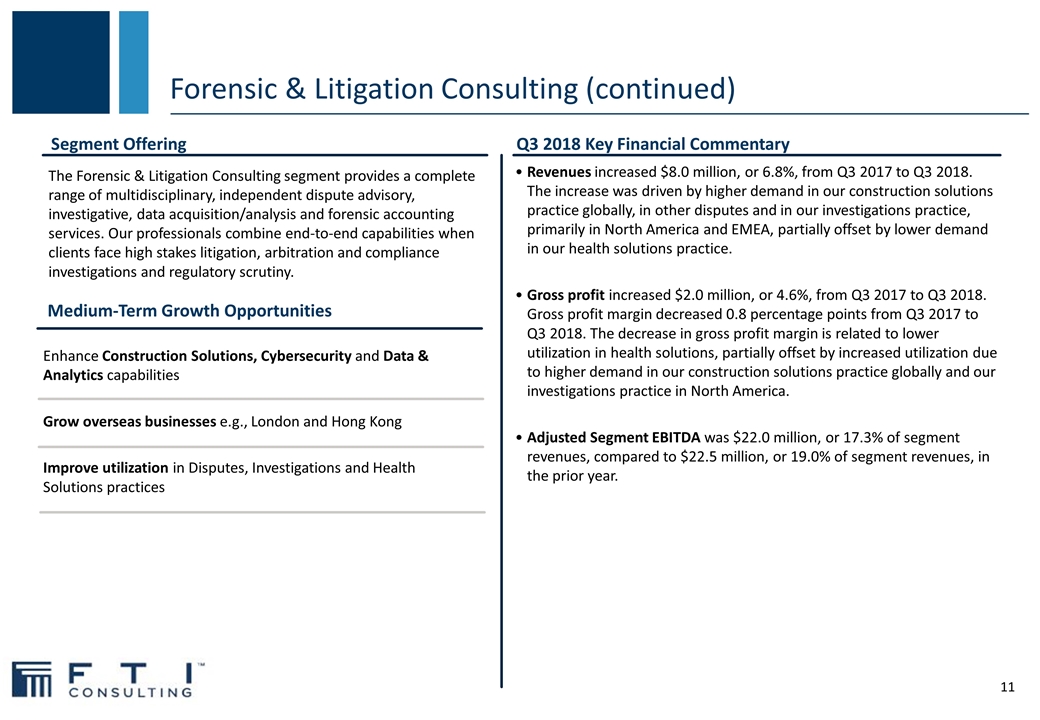
Forensic & Litigation Consulting (continued) Enhance Construction Solutions, Cybersecurity and Data & Analytics capabilities Grow overseas businesses e.g., London and Hong Kong Improve utilization in Disputes, Investigations and Health Solutions practices Segment Offering The Forensic & Litigation Consulting segment provides a complete range of multidisciplinary, independent dispute advisory, investigative, data acquisition/analysis and forensic accounting services. Our professionals combine end-to-end capabilities when clients face high stakes litigation, arbitration and compliance investigations and regulatory scrutiny. Medium-Term Growth Opportunities Revenues increased $8.0 million, or 6.8%, from Q3 2017 to Q3 2018. The increase was driven by higher demand in our construction solutions practice globally, in other disputes and in our investigations practice, primarily in North America and EMEA, partially offset by lower demand in our health solutions practice. Gross profit increased $2.0 million, or 4.6%, from Q3 2017 to Q3 2018. Gross profit margin decreased 0.8 percentage points from Q3 2017 to Q3 2018. The decrease in gross profit margin is related to lower utilization in health solutions, partially offset by increased utilization due to higher demand in our construction solutions practice globally and our investigations practice in North America. Adjusted Segment EBITDA was $22.0 million, or 17.3% of segment revenues, compared to $22.5 million, or 19.0% of segment revenues, in the prior year. Q3 2018 Key Financial Commentary

Economic Consulting 37 offices 705 professionals 15 countries Antitrust & Competition Economics Business Valuation Center for Healthcare Economics and Policy Economic Impact Analysis Intellectual Property International Arbitration Labor & Employment Services 2014 2015 2016 Q1 2017 Q2 2017 Q3 2017 Q4 2017 2017 Q1 2018 Q2 2018 Q3 2018 Segment Revenues $451,040 $447,909 $500,487 $139,221 $124,004 $111,753 $121,051 $496,029 $133,109 $133,308 $139,166 Segment Gross Profit Margin 27.0% 26.8% 27.3% 25.8% 26.1% 24.9% 26.6% 25.9% 26.7% 24.9% 27.8% Segment SG&A $65,274 $60,895 $67,383 $17,292 $18,252 $17,126 $19,273 $71,943 $17,714 $19,053 $16,874 Adjusted Segment EBITDA $59,282 $62,330 $74,102 $20,110 $15,509 $12,061 $14,284 $61,964 $19,136 $15,472 $23,238 Adjusted Segment EBITDA Margin 13.1% 13.9% 14.8% 14.4% 12.5% 10.8% 11.8% 12.5% 14.4% 11.6% 16.7% Utilization 75% 72% 73% 72% 68% 62% 64% 67% 71% 69% 71% Number of Revenue-Generating Professionals 574 599 656 660 652 688 683 683 689 695 705 (in thousands, except percentages and headcount data) (unaudited) Network Analysis Public Policy Regulated Industries Securities Litigation & Risk Management
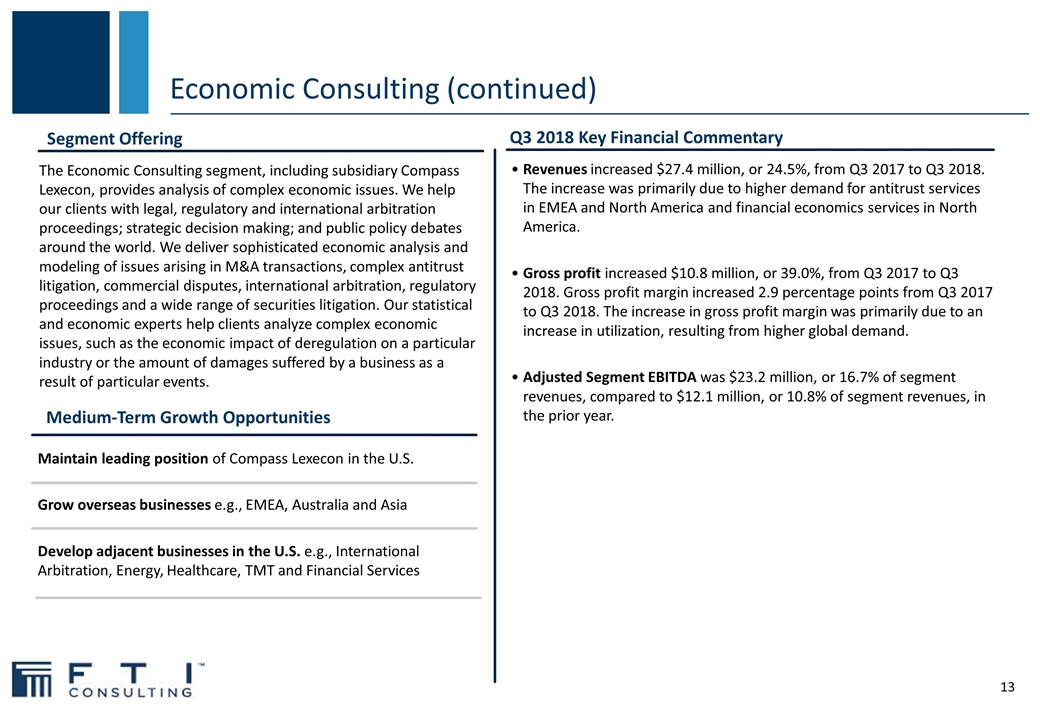
Economic Consulting (continued) Medium-Term Growth Opportunities Maintain leading position of Compass Lexecon in the U.S. Grow overseas businesses e.g., EMEA, Australia and Asia Develop adjacent businesses in the U.S. e.g., International Arbitration, Energy, Healthcare, TMT and Financial Services Segment Offering Revenues increased $27.4 million, or 24.5%, from Q3 2017 to Q3 2018. The increase was primarily due to higher demand for antitrust services in EMEA and North America and financial economics services in North America. Gross profit increased $10.8 million, or 39.0%, from Q3 2017 to Q3 2018. Gross profit margin increased 2.9 percentage points from Q3 2017 to Q3 2018. The increase in gross profit margin was primarily due to an increase in utilization, resulting from higher global demand. Adjusted Segment EBITDA was $23.2 million, or 16.7% of segment revenues, compared to $12.1 million, or 10.8% of segment revenues, in the prior year. Q3 2018 Key Financial Commentary The Economic Consulting segment, including subsidiary Compass Lexecon, provides analysis of complex economic issues. We help our clients with legal, regulatory and international arbitration proceedings; strategic decision making; and public policy debates around the world. We deliver sophisticated economic analysis and modeling of issues arising in M&A transactions, complex antitrust litigation, commercial disputes, international arbitration, regulatory proceedings and a wide range of securities litigation. Our statistical and economic experts help clients analyze complex economic issues, such as the economic impact of deregulation on a particular industry or the amount of damages suffered by a business as a result of particular events.

Technology 30 offices 303 professionals 8 countries E-discovery Services & Expertise Managed Review Computer Forensics Authorized Provider of Ringtail®, Radiance & Relativity Information Governance, Privacy & Security Services Microsoft Office 365 Migrations Services (in thousands, except percentages and headcount data) (unaudited) 2014 2015 2016 Q1 2017 Q2 2017 Q3 2017 Q4 2017 2017 Q1 2018 Q2 2018 Q3 2018 Segment Revenues $241,310 $218,599 $177,720 $46,087 $45,566 $42,282 $40,915 $174,850 $40,914 $46,429 $56,692 Segment Gross Profit Margin 48.0% 43.3% 39.5% 44.4% 39.7% 42.8% 40.8% 41.9% 39.8% 42.1% 41.5% Segment SG&A $68,162 $71,120 $64,135 $15,882 $15,683 $14,916 $16,377 $62,858 $13,621 $15,555 $15,581 Adjusted Segment EBITDA $63,545 $39,010 $25,814 $7,804 $5,421 $5,973 $2,973 $22,171 $5,732 $7,508 $11,473 Adjusted Segment EBITDA Margin 26.3% 17.8% 14.5% 16.9% 11.9% 14.1% 7.3% 12.7% 14.0% 16.2% 20.2% Number of Revenue-Generating Professionals 344 349 288 296 301 791 292 292 288 293 303 Data Remediation General Data Protection Regulation ("GDPR") Readiness Cybersecurity Contract Intelligence

Medium-Term Growth Opportunities Expand addressable market through new distribution channels for Consulting & Services Invest in new and adjacent services e.g., Information Governance, Privacy & Security Services and Contract Intelligence Grow overseas businesses e.g., Europe, Middle East and India Technology (continued) Segment Offering Revenues increased $14.4 million, or 34.1%, from Q3 2017 to Q3 2018. The increase was primarily driven by increased demand for our managed review services, largely as a result of an increase in M&A-related second request services. Gross profit increased $5.4 million, or 30.1%, from Q3 2017 to Q3 2018. Gross profit margin decreased by 1.3 percentage points from Q3 2017 to Q3 2018. The decrease in gross profit margin was due to lower pricing for higher margin hosting services, partially offset by a higher demand for managed review services. Adjusted Segment EBITDA was $11.5 million, or 20.2% of segment revenues, compared to $6.0 million, or 14.1% of segment revenues, in the prior year. Q3 2018 Key Financial Commentary Our Technology segment provides corporations and law firms with a comprehensive and global portfolio of consulting and services for information governance, privacy and security, electronic discovery ("e-discovery") and insight analytics. Our consulting expertise enables clients to more confidently govern, secure, find, analyze and rapidly understand their data in the context of compliance and risk.

Strategic Communications 34 offices 652 professionals 16 countries M&A Crisis Communications & Special Situations Capital Markets Communications Corporate Reputation Public Affairs & Government Relations People & Change Communications Digital & Creative Communications Public Affairs Strategy Consulting & Research Services 2014 2015 2016 Q1 2017 Q2 2017 Q3 2017 Q4 2017 2017 Q1 2018 Q2 2018 Q3 2018 Segment Revenues $189,367 $189,974 $191,184 $43,729 $46,248 $48,167 $54,344 $192,488 $52,790 $57,479 $55,052 Segment Gross Profit Margin 36.7% 36.3% 38.4% 34.5% 34.1% 38.3% 39.1% 36.7% 40.4% 38.8% 38.3% Segment SG&A $49,417 $43,247 $46,514 $11,591 $11,966 $10,983 $11,407 $45,947 $12,055 $11,922 $10,871 Adjusted Segment EBITDA $22,588 $27,727 $30,458 $4,257 $4,876 $8,073 $10,526 $27,732 $9,852 $10,967 $10,802 Adjusted Segment EBITDA Margin 11.9% 14.6% 15.9% 9.7% 10.5% 16.8% 19.4% 14.4% 18.7% 19.1% 19.6% Number of Revenue-Generating Professionals 566 599 647 657 659 626 630 630 630 628 652 (in thousands, except percentages and headcount data) (unaudited)
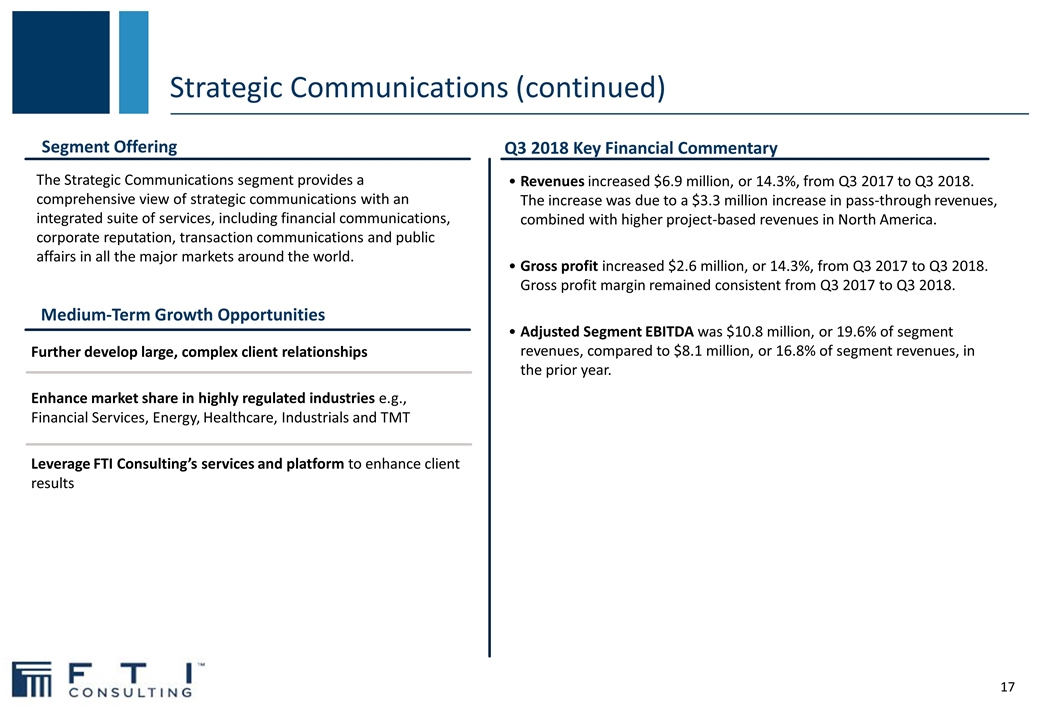
Strategic Communications (continued) The Strategic Communications segment provides a comprehensive view of strategic communications with an integrated suite of services, including financial communications, corporate reputation, transaction communications and public affairs in all the major markets around the world. Medium-Term Growth Opportunities Further develop large, complex client relationships Enhance market share in highly regulated industries e.g., Financial Services, Energy, Healthcare, Industrials and TMT Leverage FTI Consulting’s services and platform to enhance client results Segment Offering Revenues increased $6.9 million, or 14.3%, from Q3 2017 to Q3 2018. The increase was due to a $3.3 million increase in pass-through revenues, combined with higher project-based revenues in North America. Gross profit increased $2.6 million, or 14.3%, from Q3 2017 to Q3 2018. Gross profit margin remained consistent from Q3 2017 to Q3 2018. Adjusted Segment EBITDA was $10.8 million, or 19.6% of segment revenues, compared to $8.1 million, or 16.8% of segment revenues, in the prior year. Q3 2018 Key Financial Commentary

FTI Consulting named to Consulting magazine’s 2018 Best Firms to Work For list FTI Consulting and subsidiary Compass Lexecon topped Who's Who Legal’s 2018 Consulting Experts Guide for the third consecutive year FTI Consulting named Global Turnaround Consulting Firm of the Year by Global M&A Network for the fourth consecutive year FTI Consulting named #1 Restructuring Adviser on The Deal’s Bankruptcy League Tables for the eleventh consecutive year FTI Consulting recognized as an industry leader in seven categories in the New York Law Journal’s Best of 2018 Reader Rankings Third Quarter 2018 Awards & Accolades
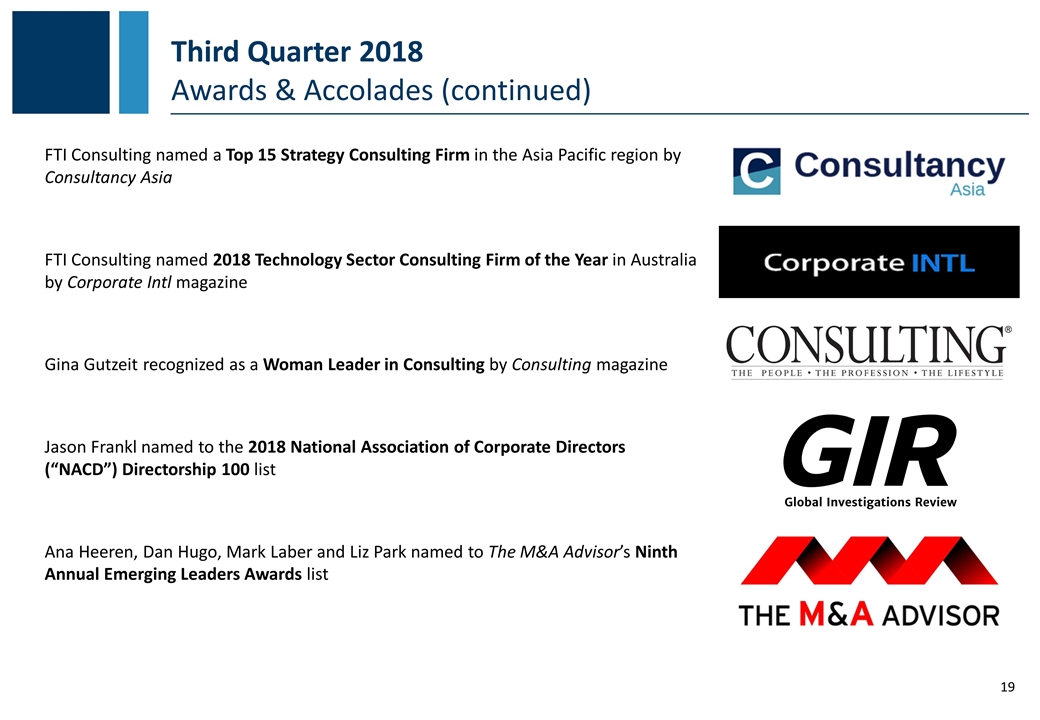
Third Quarter 2018 Awards & Accolades (continued) FTI Consulting named a Top 15 Strategy Consulting Firm in the Asia Pacific region by Consultancy Asia FTI Consulting named 2018 Technology Sector Consulting Firm of the Year in Australia by Corporate Intl magazine Gina Gutzeit recognized as a Woman Leader in Consulting by Consulting magazine Jason Frankl named to the 2018 National Association of Corporate Directors (“NACD”) Directorship 100 list Ana Heeren, Dan Hugo, Mark Laber and Liz Park named to The M&A Advisor’s Ninth Annual Emerging Leaders Awards list

Financial Overview
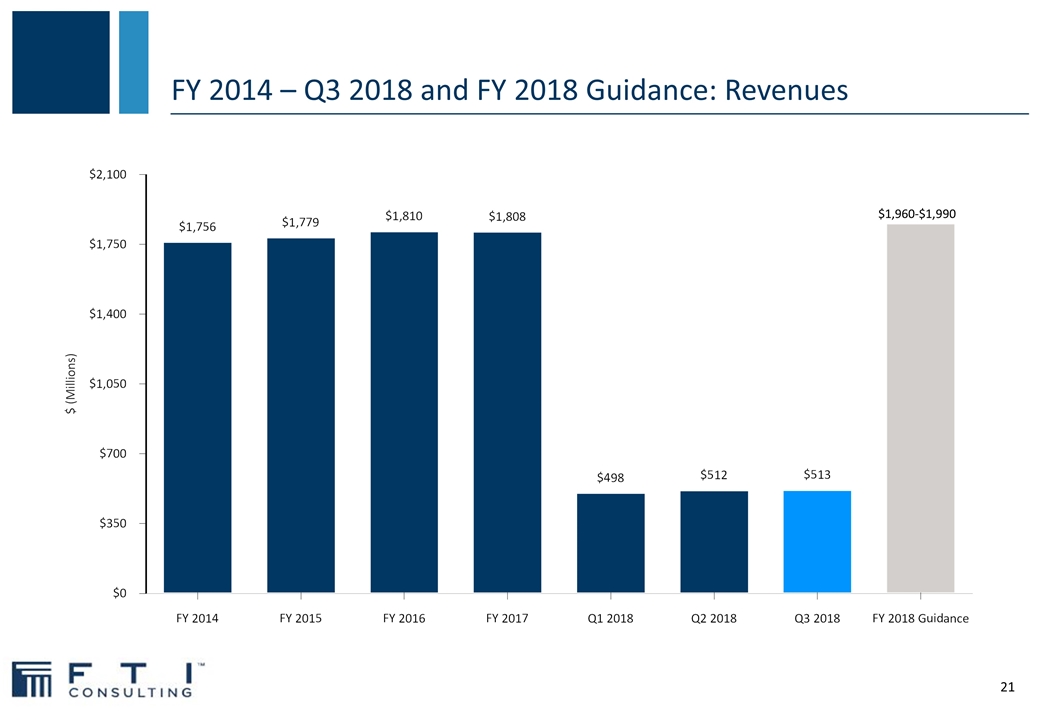
FY 2014 – Q3 2018 and FY 2018 Guidance: Revenues $1,960-$1,990

FY 2014 – Q3 2018: Net Income and Adjusted EBITDA ¹See accompanying financial tables and “End Notes: FTI Consulting Non-GAAP Financial Measures” for the definition and reconciliations of Adjusted EBITDA, which is a non-GAAP financial measure. Adjusted EBITDA (1) Net Income

FY 2014 – Q3 2018 and FY 2018 Guidance: Earnings Per Diluted Share and Adjusted Earnings Per Diluted Share ¹See accompanying financial tables and “End Notes: FTI Consulting Non-GAAP Financial Measures” for the definition and reconciliations of Adjusted Earnings Per Diluted Share, which is a non-GAAP financial measure. $3.60-$3.80 $3.53-$3.73 Adjusted Earnings Per Diluted Share (1)
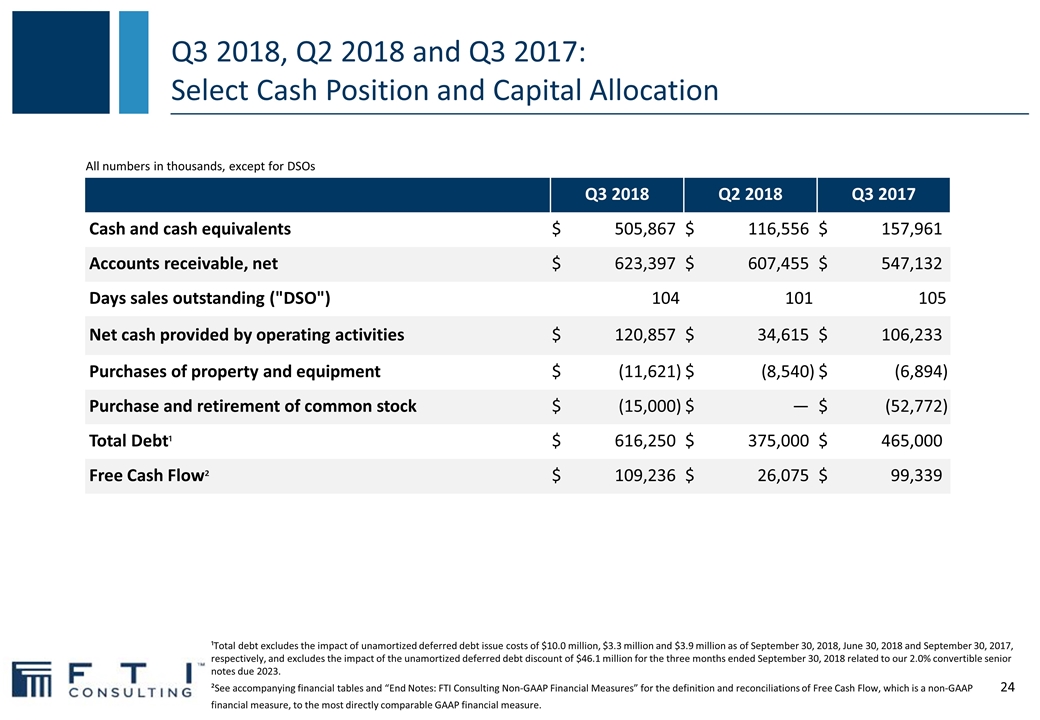
Q3 2018, Q2 2018 and Q3 2017: Select Cash Position and Capital Allocation All numbers in thousands, except for DSOs ¹Total debt excludes the impact of unamortized deferred debt issue costs of $10.0 million, $3.3 million and $3.9 million as of September 30, 2018, June 30, 2018 and September 30, 2017, respectively, and excludes the impact of the unamortized deferred debt discount of $46.1 million for the three months ended September 30, 2018 related to our 2.0% convertible senior notes due 2023. ²See accompanying financial tables and “End Notes: FTI Consulting Non-GAAP Financial Measures” for the definition and reconciliations of Free Cash Flow, which is a non-GAAP financial measure, to the most directly comparable GAAP financial measure. Q3 2018 Q3 2018 Q2 2018 Q2 2018 Q3 2017 Q3 2017 Cash and cash equivalents $ 505,867 $ 116,556 $ 157,961 Accounts receivable, net $ 623,397 $ 607,455 $ 547,132 Days sales outstanding ("DSO") 104 104 101 101 105 105 Net cash provided by operating activities $ 120,857 $ 34,615 $ 106,233 Purchases of property and equipment $ (11,621 ) $ (8,540 ) $ (6,894 ) Purchase and retirement of common stock $ (15,000 ) $ — $ (52,772 ) Total Debt¹ $ 616,250 $ 375,000 $ 465,000 Free Cash Flow² $ 109,236 $ 26,075 $ 99,339

Financial TablesReconciliations of Non-GAAP Financial Measures

Reconciliation of Net Income to Adjusted EBITDA Q3 2018 Q3 2018 Q2 2018 Q2 2018 Q1 2018 Q1 2018 FY 2017 FY 2017 FY 2016 FY 2016 FY 2015 FY 2015 FY 2014 FY 2014 Net Income $44,333 $43,609 $38,945 $107,962 $85,520 $66,053 $58,807 Income tax provision (benefit) 19,964 14,113 15,270 (20,857) 42,283 39,333 42,604 Interest income and other (1,400) (2,474) 1,800 (3,752) (10,466) (3,232) (4,670) Interest expense 7,246 6,583 6,244 25,358 24,819 42,768 50,685 Gain on sale of business (13,031) — — — — — — Loss on early extinguishment of debt — — — — — 19,589 — Depreciation and amortization 8,295 8,488 7,765 31,177 38,700 31,392 33,989 Amortization of other intangible assets 1,975 2,052 2,270 10,563 10,306 11,726 15,521 Special charges — — — 40,885 10,445 — 16,339 Remeasurement of acquisition-related contingent consideration — — — 702 1,403 (1,867) (2,723) Adjusted EBITDA1 $67,382 $72,371 $72,294 $192,038 $203,010 $205,762 $210,552 1See “End Notes: FTI Consulting Non-GAAP Financial Measures” for the definition of Adjusted EBITDA, which is a non-GAAP financial measure. (in thousands)
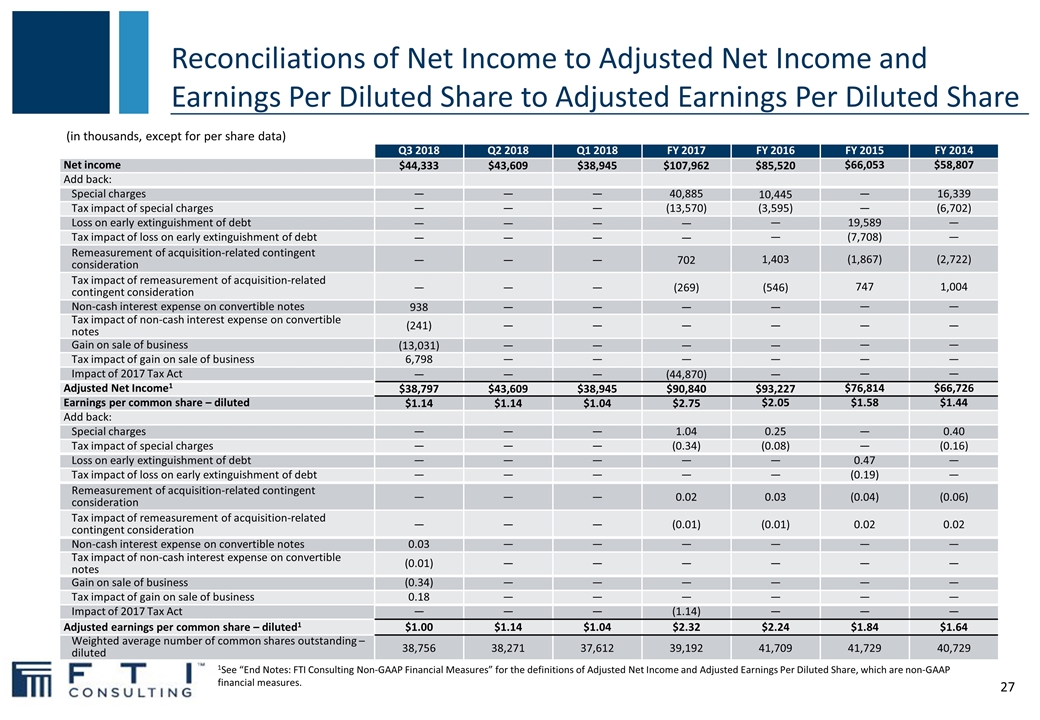
Reconciliations of Net Income to Adjusted Net Income and Earnings Per Diluted Share to Adjusted Earnings Per Diluted Share Q3 2018 Q2 2018 Q1 2018 FY 2017 FY 2016 FY 2015 FY 2014 Net income $44,333 $43,609 $38,945 $107,962 $85,520 $66,053 $58,807 Add back: Special charges — — — 40,885 10,445 — 16,339 Tax impact of special charges — — — (13,570) (3,595) — (6,702) Loss on early extinguishment of debt — — — — — 19,589 — Tax impact of loss on early extinguishment of debt — — — — — (7,708) — Remeasurement of acquisition-related contingent consideration — — — 702 1,403 (1,867) (2,722) Tax impact of remeasurement of acquisition-related contingent consideration — — — (269) (546) 747 1,004 Non-cash interest expense on convertible notes 938 — — — — — — Tax impact of non-cash interest expense on convertible notes (241) — — — — — — Gain on sale of business (13,031) — — — — — — Tax impact of gain on sale of business 6,798 — — — — — — Impact of 2017 Tax Act — — — (44,870) — — — Adjusted Net Income1 $38,797 $43,609 $38,945 $90,840 $93,227 $76,814 $66,726 Earnings per common share – diluted $1.14 $1.14 $1.04 $2.75 $2.05 $1.58 $1.44 Add back: Special charges — — — 1.04 0.25 — 0.40 Tax impact of special charges — — — (0.34) (0.08) — (0.16) Loss on early extinguishment of debt — — — — — 0.47 — Tax impact of loss on early extinguishment of debt — — — — — (0.19) — Remeasurement of acquisition-related contingent consideration — — — 0.02 0.03 (0.04) (0.06) Tax impact of remeasurement of acquisition-related contingent consideration — — — (0.01) (0.01) 0.02 0.02 Non-cash interest expense on convertible notes 0.03 — — — — — — Tax impact of non-cash interest expense on convertible notes (0.01) — — — — — — Gain on sale of business (0.34) — — — — — — Tax impact of gain on sale of business 0.18 — — — — — — Impact of 2017 Tax Act — — — (1.14) — — — Adjusted earnings per common share – diluted1 $1.00 $1.14 $1.04 $2.32 $2.24 $1.84 $1.64 Weighted average number of common shares outstanding – diluted 38,756 38,271 37,612 39,192 41,709 41,729 40,729 (in thousands, except for per share data) 1See “End Notes: FTI Consulting Non-GAAP Financial Measures” for the definitions of Adjusted Net Income and Adjusted Earnings Per Diluted Share, which are non-GAAP financial measures.

Reconciliation of Net Income to Total Adjusted Segment EBITDA 1See “End Notes: FTI Consulting Non-GAAP Financial Measures” for the definition of Total Adjusted Segment EBITDA, which is a non-GAAP financial measure. (in thousands) Q3 2018 Net Income $44,333 Add back: Income tax provision 19,964 Interest income and other (1,400) Interest expense 7,246 Gain on sale of business (13,031) Unallocated corporate expenses 27,806 Segment depreciation expense 7,388 Amortization of intangible assets 1,975 Total Adjusted Segment EBITDA1 $94,281
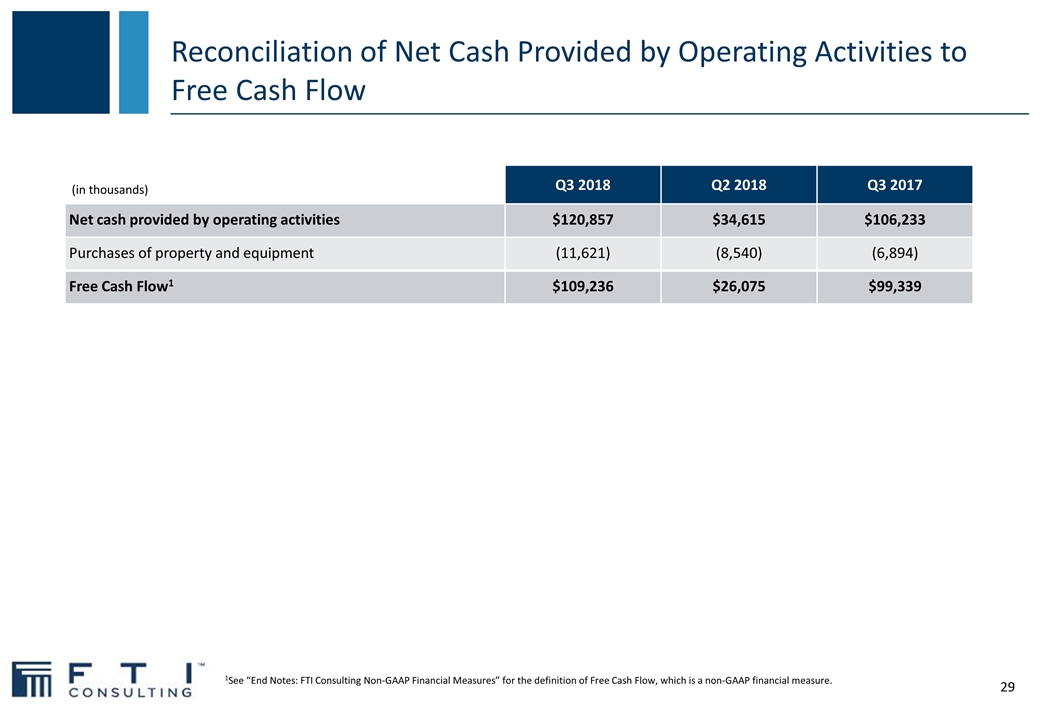
Reconciliation of Net Cash Provided by Operating Activities to Free Cash Flow Q3 2018 Q2 2018 Q3 2017 Net cash provided by operating activities $120,857 $34,615 $106,233 Purchases of property and equipment (11,621) (8,540) (6,894) Free Cash Flow1 $109,236 $26,075 $99,339 1See “End Notes: FTI Consulting Non-GAAP Financial Measures” for the definition of Free Cash Flow, which is a non-GAAP financial measure. (in thousands)

Reconciliation of Full Year 2018 EPS Guidance to Adjusted EPS Guidance Year Ended December 31, 2018 Low High Guidance on estimated earnings per common share - diluted (GAAP) 1 $3.53 $3.73 Non-cash interest expense on convertible notes, net of tax 0.06 0.06 Gain on sale of business, net of tax (0.16) (0.16) Loss on early extinguishment of debt, net of tax 0.17 0.17 Guidance on estimated adjusted earnings per common share - diluted (Non-GAAP) 1 $3.60 $3.80 1 The forward-looking guidance on estimated 2018 EPS and Adjusted EPS does not reflect other gains and losses (all of which would be excluded from Adjusted EPS) related to the future impact of remeasurement of acquisition-related contingent consideration, special charges, goodwill impairment charges and gain or loss on sale of a business, except for the actual charges taken during the nine months ended September 30, 2018, as these items are dependent on future events that are uncertain and difficult to predict.

End NotesFTI Consulting Non-GAAP Financial Measures In this presentation, we sometimes use information derived from consolidated and segment financial information that may not be presented in our financial statements or prepared in accordance with generally accepted accounting principles ("GAAP"). Certain of these measures are considered “non-GAAP financial measures” under the Securities and Exchange Commission ("SEC") rules. Specifically, we have referred to the following non-GAAP financial measures in this presentation: Total Segment Operating Income Adjusted EBITDA Total Adjusted Segment EBITDA Adjusted EBITDA Margin Adjusted Net Income Adjusted Earnings per Diluted Share Free Cash Flow We have included the definitions of Segment Operating Income and Adjusted Segment EBITDA below in order to more fully define the components of certain non-GAAP financial measures in this presentation. We define Segment Operating Income as a segment’s share of Consolidated Operating Income. We define Total Segment Operating Income, a non-GAAP financial measure, as the total of Segment Operating Income for all segments, which excludes unallocated corporate expenses. We use Segment Operating Income for the purpose of calculating Adjusted Segment EBITDA. We define Adjusted Segment EBITDA as a segment’s share of Consolidated Operating Income before depreciation, amortization of intangible assets, remeasurement of acquisition-related contingent consideration, special charges and goodwill impairment charges. We use Adjusted Segment EBITDA as a basis to internally evaluate the financial performance of our segments because we believe it reflects current core operating performance and provides an indicator of the segment’s ability to generate cash. We define Adjusted EBITDA Margin as Adjusted EBITDA as a percentage of total revenues. We define Total Adjusted Segment EBITDA, which is a non-GAAP financial measure, as the total of Adjusted Segment EBITDA for all segments, which excludes unallocated corporate expenses. We define Adjusted EBITDA, which is a non-GAAP financial measure, as consolidated net income before income tax provision, other non-operating income (expense), depreciation, amortization of intangible assets, remeasurement of acquisition-related contingent consideration, special charges, goodwill impairment charges and losses on early extinguishment of debt. We believe that the non-GAAP financial measures, which exclude the effects of remeasurement of acquisition-related contingent consideration, special charges, goodwill impairment charges and losses on early extinguishment of debt, when considered together with our GAAP financial results and GAAP measures, provide management and investors with a more complete understanding of our operating results, including underlying trends. In addition, EBITDA is a common alternative measure of operating performance used by many of our competitors. It is used by investors, financial analysts, rating agencies and others to value and compare the financial performance of companies in our industry. Therefore, we also believe that these measures, considered along with corresponding GAAP measures, provide management and investors with additional information for comparison of our operating results with the operating results of other companies. We define Adjusted Net Income and Adjusted Earnings per Diluted Share (“Adjusted EPS”), which are non-GAAP financial measures, as net income and earnings per diluted share ("EPS"), respectively, excluding the impact of remeasurement of acquisition-related contingent consideration, special charges, goodwill impairment charges, losses on early extinguishment of debt, non-cash interest expense on convertible notes, gain or loss on sale of a business and the impact of adopting the 2017 U.S. Tax Cuts and Jobs Act (“2017 Tax Act”). We use Adjusted Net Income for the purpose of calculating Adjusted EPS. Management uses Adjusted EPS to assess total Company operating performance on a consistent basis. We believe that this non-GAAP financial measure, which excludes the effects of the remeasurement of acquisition-related contingent consideration, special charges, goodwill impairment charges, losses on early extinguishment of debt, non-cash interest expense on convertible notes, gain or loss on sale of a business and the impact of adopting the 2017 Tax Act, when considered together with our GAAP financial results, provides management and investors with an additional understanding of our business operating results, including underlying trends. We define Free Cash Flow as net cash provided by operating activities less cash payments for purchases of property and equipment. We believe this non-GAAP financial measure, when considered together with our GAAP financial results, provides management and investors with an additional understanding of the Company’s ability to generate cash for ongoing business operations and other capital deployment. Non-GAAP financial measures are not defined in the same manner by all companies and may not be comparable with other similarly titled measures of other companies. Non-GAAP financial measures should be considered in addition to, but not as a substitute for or superior to, the information contained in our Condensed Consolidated Statements of Comprehensive Income.
